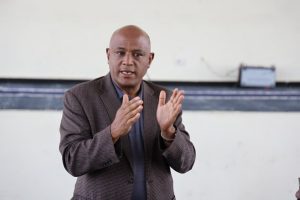Food Politics have shifted the main schemas of political economy of Ethiopia and societal structure. It has impact on country’s livelihood security as well. Of course, addressing illiteracy should be one of the priorities for any country. Beside poverty alleviation program, other issues must be addressed.
In this case, The Ethiopian Herald has approached Former United Nations policy Advisor in New York, Dr. Costantinos Berhutesfa, to relate to our esteemed readers about food politics. Excerpts;
Herald: Tell us about the backdrop of food politics here in Ethiopia?
In 1984, famine began to strike Ethiopia with apocalyptic force. Westerners watched in horror as the images of death filled their TV screens: the rows of fly-haunted corpses, the skeletal orphans crouched in pain, the villagers desperately scrambling for bags of grain dropped from the sky. What started out as a trickle of aid turned into a billion-dollar flood.
The rescue effort was plagued by delays and controversy, and some one million Ethiopians eventually died, but eight million more would have perished if the Red Cross and the world had not responded so generously.
Such are the horrors of famine perpetrated by bad governments that the global community had to assert that famine should be relegated to the limbo of history. The tragedy, which took such a heavy toll of life over the past years, has highlighted the fundamental weakness of strategies in coping with poverty and disasters that impact upon people as a result. Poverty triggering agents are multifaceted and cannot solely be attributed to climatic factors.
The irony is Ethiopia, a nation known as the water tower of North-East Africa, is the epicenter of famines. With 74 million hectares of arable land and surface water resources in Ethiopia flow in 12 major river basins. It is estimated that an average of 122.19 billion cubic metres of water is annually discharged from the Abay, Tekeze, Baro, and Omo-Gibe river basins with an estimated 3.5 million ha of irrigable land.
However, because land developed for irrigation to date has not been a small percent of the potential, Ethiopia comes down to a low position for actual utilization of water resources for irrigation. Because of Ethiopia’s topography the rivers have enormous hydropower generating capacity estimated at 650 Terra Watts, of which very little of this capacity is being actually used.
Herald: Do you think that food politics can make sense for human security of the country?
The long-term objective is to establish once and for all a nation that can ensure its citizenry human development and human security. Abay River and the Gibe-Omo basin are just two of the many projects expected to contribute to this vision. Understandably, Ethiopia has now launched major economic and social rehabilitation scheme to get famine behind its back. Indeed, the economy has recently been growing at 10 per cent and provides opportunities to finance development within.
Development and humanitarian practitioners ensemble, believe that massive food production and the energy required to fuel such development is the only way that the nations can shed the stigma of famine. Controversies notwithstanding, we must put in place well-researched studies on their impacts and advance dialogue forums to address the potential gains of such projects and the human and environmental impact of such undertakings.
In the early 1980s, the Ethiopian Highlands Reclamation Study concluded that soil erosion and degradation in the breadbasket of Ethiopia had reached crisis proportions. Between the Great African famine of 1984 and 1991 crop failures, civil war and political unrest increasingly hampered progress in the highlands of Ethiopia.
Survival alone became the objective. Food aid initially intended for development was needed to address pressing emergencies. Relief food comes late, and had to be dispatched immediately to address life-threatening situations. Technical and managerial time and expertise, never plentiful, were redeployed for emergencies.
In 1991, the Dergue perished and changes were introduced to development and relief food aid programmes. In development, local community planning was incorporated, and investment in technical and community skills was increased. In relief, the new government recognized that the much larger relief food aid flows needed to be harnessed.
However, the relief programme had fatal flaws: relief food was unreliable, often too little and coming too late; essential complementary inputs like tools, equipment and supplies were largely unavailable. Government agencies did not accept their responsibilities and did not enforce them, as there were too many competing priorities.
The vast majority of this has been emergency food aid. Ethiopia is the largest recipient of emergency aid per capita in Africa, but receives the least investment in development aid for each citizen.
Herald: Do you think that food insecurity is the main challenge for Ethiopian society?
While no one questions the need to save lives, the failure to invest in food security programmes for the poor is doing little to break the cycle of food crisis. Food insecurity remains a key challenge in Ethiopia, which predominantly affects pastoralist and agro-pastoralist households, with the highest proportion of food insecure people living in Oromia which is about 44 per cent.
Some 8.4 million people nationwide are projected to have humanitarian needs in 2020, the majority of whom are in Oromia which amounted 3.3 million of 9 per cent of the region population, followed by
Somali numbered 2.4 million of 39 per cent of population and Amhara which is 1.0 million of 4 per cent of population regions.
Of the 8.4 million people in need, 74 per cent have acute needs that need to be immediately addressed. The number of people in survival deficit, decreased from 4.48 million in 2019 to 2.8 million persons projected in 2020. The most notable drop in acute needs was found in Oromia state, from 2.66 million to 1.1 million persons.
The biblical famines of Ethiopia were deliberately hidden so as to preserve the image of the imperial regime or of the Dergue military junta. Even more recently, both the authorities and the donor community publicly denied the acuteness of the food crisis for three to four months, thus leading to a corresponding delay in the aid delivery. Again, the reaction of the authorities is under strong criticism here and there.
The mood within the power circle is one of relaxation. One can hardly find the sense of urgency expected. The response system remains fragmented. There is no functioning integration between risk assessment units, response institutions, local administrations and federal units. The whole response system seems to host great inefficiency
The Gambella State announced that it has cancelled commercial agricultural development investment licenses. According to information provided by the state’s Press Secretary to the state press office, Udud Ujulu, the agricultural farm for investment in 2008, there were over 700 investors. Some 285 of them have not made any development, and their investment license has been cancelled and more than 200,000 hectares of land has been transferred to the Land Bank. He said 36 out of 285 investors have taken out loans from the Development Bank. Investors who had their investment license cancelled were not engaged in work, started working, paid no land use, tax, and had been denied entry to work.
Herald: thinking of vulnerability through means of food politics setting in the mind state of politicians and other local based stakeholders, what is your comment in this regard?
These biblical famines have emerged the need to create attitudinal changes very much imperative in so many quarters. Consequently, the understanding of vulnerability and its effects has improved in the past decade and considerable efforts have been made to improve the quality
of disaster preparedness, prevention and development. Many conventional and preconceived notions have been questioned and new ideas proposed.
Herald: what decisive measures should the country take to respond for food insecurity and to think on famine prevention mechanisms?
Efforts have also been made to improve our understanding of disasters, to estimate the risks resulting therefrom more accurately and to make adequate precautionary or preventive measures ahead of disasters. The traditional role of relief and development organizations to provide emergency assistance to victims of disasters has been harshly, even cruelly tested; in peoples’ inability to reduce peoples’ vulnerabilities.
As a result, this has enabled us to break fresh grounds in the new conceptualisation of the dialectical percept of the process with relief to sustainable development; paving the way for the furtherance of preparedness modalities and the philosophical underpinning of the relief-development nexus itself. This approach will, to a large extent, influence the current programme planning.
The need for collective learning about disaster responses, and the responsibility to those whose suffering provided the basis for that learning will never be more urgent than it is now. “Lest We Forget” could stand as the disaster response maxim of the new century ahead, reminding us that the demanding standards of traditional principles have to be met within a context of constantly changing circumstances which dictate changing practices.
The daunting task of tackling the problems of a threatening and complex environment requires the extension of the voluntary sharing of energies, ideas and resources, which is at the heart of the philosophy of the preparedness-relief-prevention continuum in developing both our understanding of and response to disasters.
The urgency of this requirement can hardly be exaggerated. Unfortunately, lessons, which may be learned through the shocks administered by an uncompromising reality, are rarely translated quickly into organisational memories and the inherent will to change. The reasons for this are sometimes rooted in human inertia, weakness and self-interest. They are equally often the product of a genuine confusion about how to act most effectively in a nation whose socio-political environment seems to be growing more complex.
The Ethiopian Herald May 3/2020
BY MEHARI BEYENE





